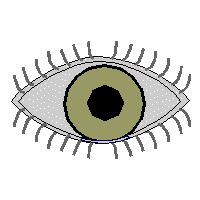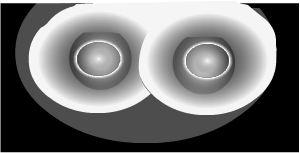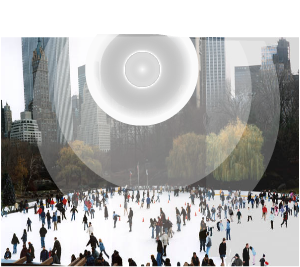Cataracts |
|
|
What is a cataract? |
|
Normally light enters the eye from the front, passes through a clear lens, and reaches the back of the eye so you can see. If the lens becomes cloudy like frosted glass, light cannot pass through, and you cannot see properly. 'Cataract' is the name of the 'cloudy' human lens. |
|
|
top: a clear lens, no cataract. Light enters the eye directly. bottom: a cloudy lens = a cataract. Light entering the eye is scattered. |
|
|
Think of a camera, with a lens that bends the light so that the light 'focuses' onto the film at the back. If this lens becomes scratched or greasy, it cannot bend the light in the correct direction, and the light is scattered in all directions. You may notice blurred or misty sight, see double, or notice colours appear much duller than they did previously. |
 |
|
What you can do |
| A cataract will not damage your eye in any way. It can be operated on safely at any time, thick or thin. A cataract may change the focusing in the eye, and you may need new spectacles now and again. If you think you do, ask your optometrist (optician) or the doctor in the hospital eye clinic. But glasses themselves do not help you see better if you have a cataract. Some cataracts get worse quickly, others slowly: most do get worse over months or years. If your sight gets worse very slowly, the cataract is only slowly becoming thick. The thicker or cloudier the cataract becomes, the worse the sight. A doctor cannot predict with certainty. |
Reading |
|
Large print is naturally much easier to read, and a magnifying glass may help (see Coping with poor vision). A good light may help, particularly an anglepoise light behind the shoulder. Stronger glasses that mean you can bring books closer to your eye to make reading easier, and an optician (optometrist) can advise you.
|
|
Driving |
| You may notice great difficulty driving at night, when car headlights are shining into your eye. This may be so bad you have to stop driving at night, and at this stage, if you want to keep driving, you may need a cataract operation. |  |
|
Sunlight |
|
You may notice difficulty seeing in sunlight. Dark glasses may help, or a hat with a large peak. Eventually you usually need an operation. |
 |
Causes of cataracts |
Cataracts occur as people get older. They are much commoner if you smoke, whether cigarettes, cigars, or a pipe. They are commoner in people with hypertension. They occur more often in diabetes, and they can run in families. Steroid tablets may help to cause cataracts if given at a high dose or for a long time. See details below. There are many other causes, including other types of eye disease and eye injury. Epidemiology in more detail. In the UK smoking contributes to 25% of cataracts, 17% in Denmark. Some smokers may have not have developed cataracts otherwise, and in other people they may have become denser because of the smoking (increasing the risk 2-4 times, also ). Beaver Dam 2008. Passive smoking will contribute significantly. Diabetes similarly contributes to 25% of the UK's cataracts. Recent research and also and also has shown that dietary factors such as high cholesterol and low levels of lutein and zeaxanthin (in vegetables and fruit) are found in cataract patients. This indicates that a healthy diet will help substantially to prevent cataracts. A healthy diet should be balanced, include 5 portions of vegetables and fruit a day, have no added salt, and little saturated or trans fats (these are in animal fats such as red meat and dairy food, and include some 'hard' vegetable fats in many biscuits and cakes) and include 2 portions of oily fish such as sardine, tuna, or salmon a week. Lots of vitamins (as in vegetables and salads) will reduce the likelihood of cataracts Carotenoids, Vitamins C and E. Statins contribute to cataracts.
|
Does a cataract damage the eye, or your other eye? |
|
A cataract does not usually damage your eye in any way. A cataract in one eye cannot lead to any damage in the other eye, and you cannot use the good eye too much and damage it. Similarly, sit close to the television if this helps you see it better: this will not damage your eyes. A cataract often develops in the other eye, but many people only get one in one eye. |
Will your sight & the cataract get worse? |
|
Many cataracts do get worse, especially if you are middle aged and have diabetes. Many people with diabetes do eventually need cataract surgery. |
Does a diet help? |
|
UK Department of Health advise a diet low in animal fat and salt, with five portions of vegetables or fruit a day, with 30 minutes exercise such as walking, and not smoking. In diabetes, diet, control of the blood sugar and blood pressure are important to prevent other problems. A healthy diet postpones cataracts (AJO 2010: a poor diet & obesity increases risk by ~50%) |
Photos |
Cataract...nuclear sclerosis. Cataract is slightly brown, and colours do not sem as brgiht to the patient larger |
Mature cataract...very dense with very poor vision. Such cataracts are uncommon except in the most deprived communities. larger |
When do you need an operation? |
An operation to remove the cataract is usually the only way to make improve your sight. But before you can decide, you need to know the pros and cons of an operation. A cataract operation is generally safe, and with a surgeon who is experienced in small incision cataract, the risk of a serious problem is about 1%. So in a way you are the best person to decide: certainly, if you
cannot do what you want to do, such as read, watch TV, or
walk in the street, an operation is usually helpful (if your eye
has no other conditions.) See animation and another |
The Operation |
See after your operation at Good Hope or BMEC Typically, you have the operation as a day case. You go to the hospital in the morning, and go home later that day. You have a local anaesthetic injection, wait for it to work, then have the operation which takes about 20-30 minutes. A small cut is made and a small tube is inserted into the eye to suck the cataract out, and a plastic lens implant is put in its place. The plastic lens implant is placed in the 'capsule' of the cataract. Routinely, the only major discomfort can be the local anaesthetic injection. At home, you have drops to put in, and routinely have one to the hospital before seeing your optician for glasses. Normally after an operation, you see well. However, if there are other problems in your eye, such as a damaged retina (the film at the back of the eye), your sight will not be so good. In diabetes the operation may make the retinopathy worse and laser may be needed. Often the ophthalmologist recommends laser before the operation to try and stabilise the retinopathy. (See page concerning your type of retinopathy.)
|
A small hole is made in the side of the eye and a probe is placed in the eye to cut and suck the cataract out.
|
|
A plastic lens is placed in the eye to replace the cataract. The lens focuses the light onto the retina, like the lens of a camera. |
Glasses |
|
You will usually need glasses after cataract surgery. Sometimes you only need them for reading. Many people see well after surgery without glasses, but that little bit better with them. |
 |
Glasses ..more details |
|
The size of your eye is measured before your operation so your doctor can determine which implant to use. Normally
|
Risks | |
The are risks with cataract surgery. Approximately 1% of patients do develop serious complications, and this risk can be higher if your cataract is thick, for example. Professionals see risks here |
|
Flomax (tamulosin) |
|
This drug may cause a floppy iris during your cataract operation. Please tell your ophthalmologist if you have ever had this drug. If your GP wants to give you the drug, and you are about to have cataract surgery, it is important to wait until after the cataract surgery before starting it. |
|
Fuchs corneal dystrophy & cataract surgery |
This condition is explained starting here. Cataract surgery is more risky in this condition, as Fuchs dystrophy and the surgery can combine to damage the cornea permanently. New research suggests what surgery with care and the latest techniques and viscoelastics on eyes with corneal thickness <640um is safe, without a corneal transplant. |
||
Trabeculectomy & cataract surgery |
Cataract surgery might affect previous glaucoma surgery. If you have had a trabeculectomy in the eye needing cataract surgery, you have a choice.
Ar Good Hope we recommend the first option, particularly if the cataract operation is likely to be complicated (e.g. if there is a small pupil, if the glaucoma is advanced, if there has been uveitis etc) |
Trabeculectomy surgery creates a valve that lets aqueous fluid seep out of the eye. This valve may block if anti-scarring drugs are not given at time of cataract surgery. |
|
Drugs that contribute to cataracts |
Two common types of drugs contribute to cataracts
|
ps technical check list/consent
| The address of this site ('org' changing to 'nhs') is changing from http://www.goodhope.org.uk/departments/eyedept/ to http://www.goodhope.nhs.uk/departments/eyedept/ |
|